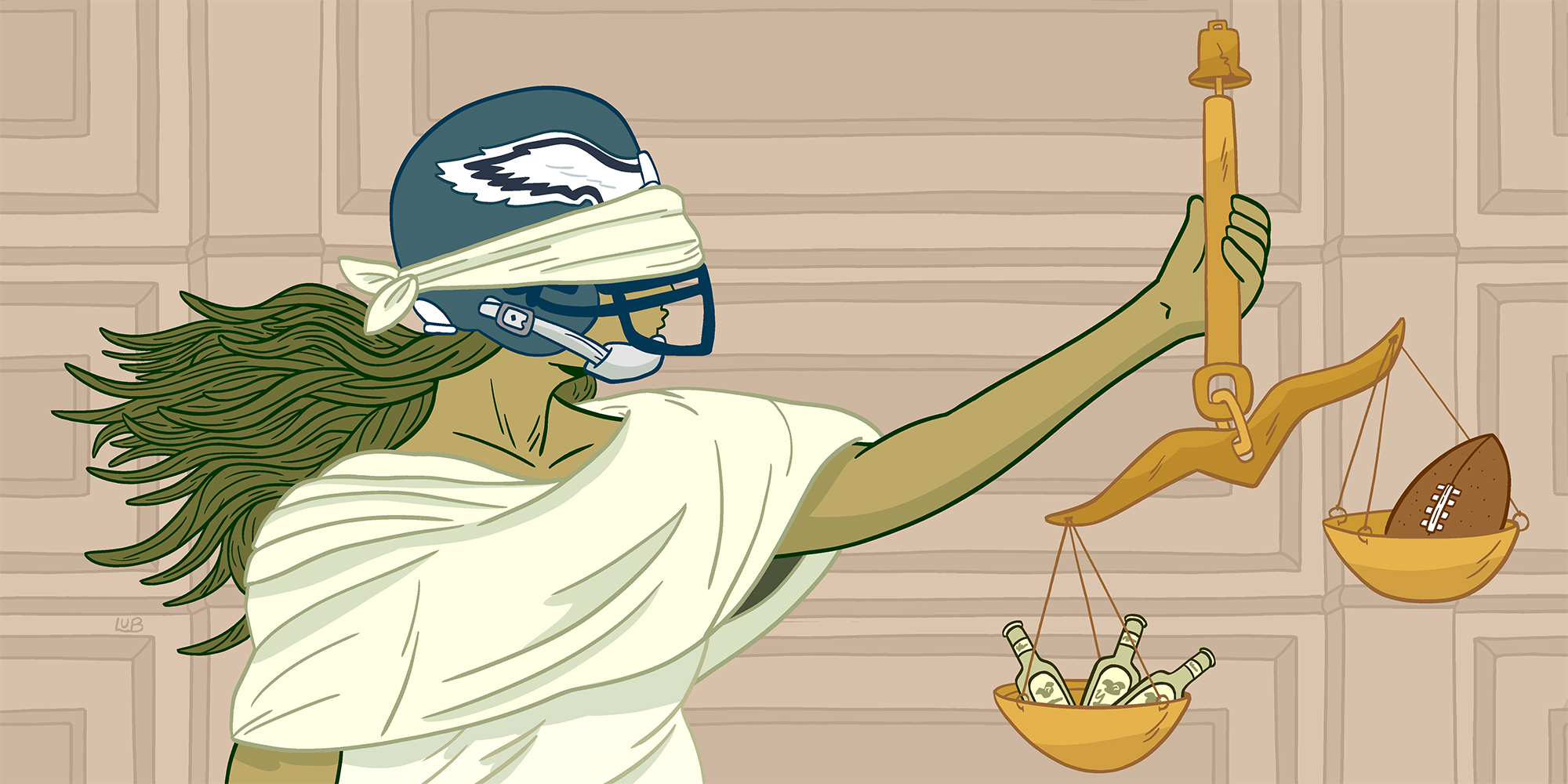On Nov. 10, 1997, the Philadelphia Eagles were losing at home to the San Francisco 49ers on Monday Night Football during an otherwise forgettable 6-9-1 season. The final score of that game, 24-12, hardly reflected the chaos that ensued that night: Over 60 fans were ejected after incidents at the stadium, the most serious of which was a man who brought a flare gun to the game and fired it over the field to the other side of the stadium. It was an embarrassment to the Eagles and to Philadelphia, as the bad publicity necessitated that officials do something. The collective wisdom of team and city officials came together to produce what is now known as Eagles Court.
Contemporaneous newspaper accounts of Eagles Court were published when it was in operation (plus a few more recent retrospective pieces), but there are significant gaps in the popular understanding of how the court was established, how it operated, and its ultimate demise. We want to first acknowledge that it would be easy to chalk up Eagles Court as just another entry in the Philadelphia Sports Hall of Shame. This piece is not intended to do that; as criminal justice researchers, we set out to analyze this seemingly quixotic courtroom through the historical lens of crime rates and justice system innovations of the 1990s. What we found was that Eagles Court is a story of a city struggling to curb crime and violence, an ambitious municipal court judge, a new team owner trying to change a franchise’s reputation, and the enduring myths and less scintillating truths of criminal justice in America in general, and Philadelphia sports history in particular. And a funny thing happened in our research: We found that almost everything that endures in the popular imagination about Eagles Court was wrong.
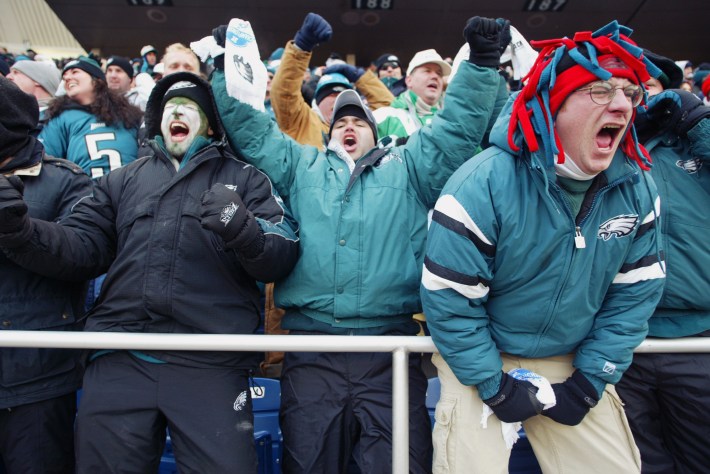
Crime in America has been a major public concern since the 1960s. An upward trend in the crime rate continued into the ‘70s, accelerated in the mid-’80s, and the so-called “crime boom” peaked between 1991 and 1993. Philadelphia, along with nearly every other city in the United States, was grappling with historic levels of crime and disorder. This was the era of crack babies and super-predators, which were nothing if not thinly veiled racialized stereotypes, and it was the dawn of what we now understand as mass incarceration. In just a few decades, the United States went from a couple hundred thousand people behind bars to more than 2 million, thanks to lengthy mandatory sentences such as three-strikes laws. All corners of American public life—politics, academia, police, and the legal system more broadly—were focused on explaining and alleviating the historically high crime rate using whatever tools were available at the time, and inventing some along the way.
The majority of the policies fit with what we now call the “Get Tough” era: more police, more prosecutors, more prisons, and new laws that extended terms of incarceration to unprecedented and sometimes ridiculous lengths. Research examining what led to the downturn of property and violent crime rates starting in the mid-’90s credits only part of the precipitous decline to these Get Tough innovations.
A less-heralded movement (at least at the time) began in 1989 when Janet Reno, then the District Attorney of Dade County, Florida, established the nation’s first “drug court.” Designed to treat the root causes of crime—in this case, diverting people with substance-use disorders away from overcrowded courtrooms and jails—drug court brought a softer touch, and fewer headlines.
Reno’s court was viewed as a more palatable or even humane approach to the crime problem, and it was arguably one of the selling points for her nomination by Bill Clinton to be the country’s first female attorney general. Well into the 2000s, drug courts proliferated as they were seen as effective at reducing recidivism. The Dade County drug court kicked off a broader movement to tailor courtrooms that addressed a variety of specific issues and offenders such as mental health, domestic violence, military veterans, and guns, even if a serious critique of “net-widening” can be leveled at them. Collectively, these courts have come to be known under the umbrella terms of “specialty courts,” “treatment courts,” or “problem-solving courts.”
Another variant of the problem-solving court movement is known as “nuisance night court.” By targeting low-level crimes such as disorderly conduct, trespassing, public intoxication, and other minor offenses, these courts dealt with violations that were less serious than misdemeanors but were in the interest of the community to not go unaddressed.
(Night courts fit nicely in the vein of the 1980s’ broken windows theory of crime and disorder, which posits that when low levels of law-breaking go unpunished, it will invariably give rise to more serious crime. It is otherwise known as a quality-of-life approach to sweating the small stuff in order to prevent the big stuff. Never mind that social science research has roundly debunked it.)
Nuisance courts were place- and event-based, in that they were typically set up close to where and when the disorder was most likely to occur, where the cases could be adjudicated quickly, and, ideally, where they would serve as a deterrent to unruly behavior. Veterans Stadium seemed an ideal location to test the theory.
The stories are so ubiquitous, they're almost not worth rehashing: Santa vs. snowballs. J.D. Drew vs. batteries. Michael Irvin vs. AstroTurf. Donovan McNabb vs. everyone. Philadelphia and its sports fans endure a stereotype constantly reinforced by a national sports media too lazy to update its priors, but Veterans Stadium and the fans who inhabited it certainly contributed to that reputation. This was in no small part due to the 700 level, the upper ring of seats that were the cheapest tickets to be had and where the most problematic behavior was often found.
When it opened in 1971, the multi-sport, cookie-cutter Veterans Stadium was state of the art, but it aged rather rapidly and in unfixable ways. It was far too big, especially for baseball, and was hard to maintain; it had carcinogenic AstroTurf that could be described as I-95 painted green. By the time the Eagles left after the 2002 season and the Phillies moved to their new baseball-only park in 2004, the Vet had become anything but cutting-edge. It smelled and it was falling apart and there were not enough bathrooms. Twenty years since the Vet was imploded to make way for a parking lot, the legend of the stadium endures, including on the bootleg T-shirts sold in that lot.
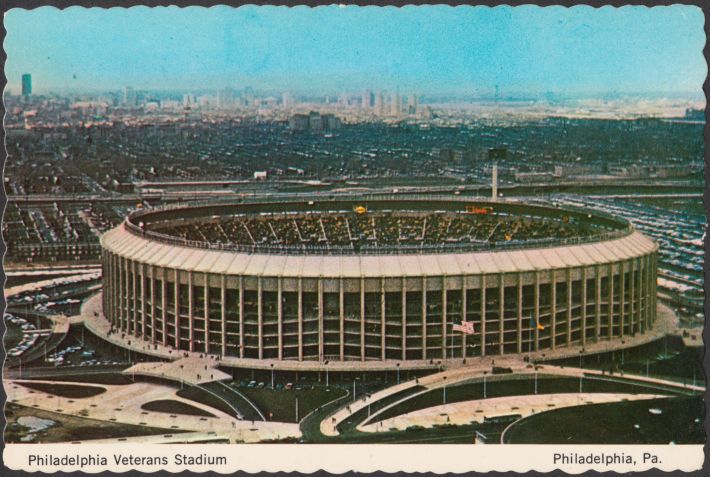
While not excusing the unruliness of fans at Veterans Stadium, we should acknowledge its circular design as a contributor to the bad behavior. The Vet, like its bygone brethren Riverfront Stadium in Cincinnati, Three Rivers Stadium in Pittsburgh, and the old Busch Stadium in St. Louis, allowed fans to circumnavigate the stadium both in the stands and on the concourse where concessions and bathrooms were located, increasing the number of fans mixing with one another and mixing it up with one another. It is difficult to say if the architects of these stadiums ever imagined their creations, with seamless contiguous designs, would actually make bad behavior more likely, but it was surely an unintended consequence. Moreover, as the number of bathrooms did not match the demand for them during Eagles games, fans were forced to walk a distance to find one, increasing the likelihood of an interaction turning into an altercation. This is to say nothing of the shortage of bathroom facilities itself leading to behavior that might have landed one in Eagles Court.
Which brings us to 1997. Whereas violent and property crime rates were falling nationally, Philadelphia still had not yet begun to see the “crime bust” other cities were experiencing. The city ended that year with 418 homicides, its ninth straight of over 400 killings, and the mayor, city council, police department, the district attorney’s office, and everyone involved in the criminal justice system were desperate to bring the crime rate down, with all options on the table.
Frustrated and embarrassed on the national stage after the Monday Night Football debacle, then–councilman Jim Kenney approached then–Municipal Court judge Seamus McCaffery to work out a solution. Just a year prior, Philadelphia had implemented its own version of nuisance night court, and these officials were intent on bringing justice directly to the stadium.
Talking about Eagles Court with family members, friends, acquaintances, and perfect strangers, we found that any Philadelphian sentient in the late ‘90s has a memory of the latter years of the Eagles’ residency in Veterans Stadium and its infamous courtroom. Most of those recollections and opinions, we found, were wrong. For instance, we heard a story of a guy who allegedly found himself in Eagles Court, and he provided us a copy of the citation he received for climbing “atop stadium lights at Vet” [sic]. Other than being ridiculously dangerous, making one’s way to the catwalk of the Vet would be an easy case to prosecute in any court, but in this instance, it happened 14 months before a courtroom was installed in the bowels of the aging stadium. Eagles Crime, but not Eagles Court.
Myths are powerful and memories are not, and this project has turned us into quintessential Well, Actually guys. Here are four of the most common myths and our attempt to correct the record on each:
Myth No. 1: Eagles Court handled all crimes at the Vet.
In the spirit of nuisance night court, Eagles Court was explicitly established to handle the least serious misdemeanors and what are known as “summary” offenses. These are largely related to alcohol consumption: disorderly conduct, minor physical altercations, and, of course, public intoxication. Previously, as in the case of the fan who made it to the catwalk, individuals had been given a summons to appear in a regular courthouse at a later date, some number of them would fail to appear, justice would be at least delayed, and with it, a host of negative outcomes could ensue. Eagles Court, like its night court antecedent, was intended to close the spatiotemporal gap between behavior and punishment and serve as a deterrent to others, bringing peace and justice to an unruly stadium.
All of which is to say that when a more serious crime occurred inside Veterans Stadium, it was outside of Eagles Court’s jurisdiction. For instance, at the home opener on Sept. 9, 2001, a fan of the visiting Rams was in attendance in the 700 level, proudly wearing his team’s jersey. Throughout the game, he endured “good-natured ribbing,” according to an account published in the Philadelphia Daily News, until the behavior turned violent. Someone threw a bottle in his direction, striking his girlfriend, and he was subsequently attacked by multiple others, resulting in a cut under his eye that required several stitches. One of his attackers was immediately arrested by a police officer who witnessed the crime, and the suspect was charged with aggravated assault, a serious felony charge that was most certainly not handled in Eagles Court. The fan ultimately pleaded guilty to simple assault and was sentenced to two years of probation.
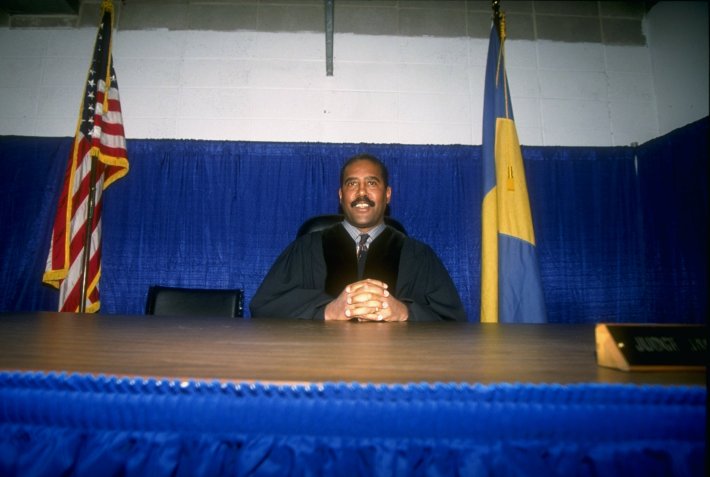
Myth No. 2: A jail was set up in the stadium.
Beyond academic criminal justice circles, the precise definitions of jail, prison, and courtroom are often misunderstood. In the broadest sense of the word, a jail is a locally run, short-term holding facility for criminal defendants awaiting trial, and for those who have been convicted and sentenced to relatively brief terms of incarceration. When Eagles Court was established in 1997, according to former Philadelphia Police Officer Anthony "Butch" Buchanico (whose father was head of Eagles security at the time), the city repurposed a storage room in the stadium, which he affectionately called the “sweatbox” because of its lack of ventilation, to serve as the waiting area for those on their way to see Judge McCaffery. The several accounts of Eagles Court that used the term “jail” seemingly did so for descriptive purposes, but the sweatbox was certainly not anything resembling a jail, and upon conviction, no one served their time at the Vet.
Procedurally, Eagles Court did not function like a traditional courtroom, as nuisance night courts and the low-level defendants adjudicated in them are not afforded the same due process rights as more serious offenders. There was no bail, and the trials, such as they were, consisted of the judge hearing testimony from the arresting officer or security guard, giving the defendant an opportunity to speak, and then handing out a couple-hundred-dollar fine and perhaps some community service for the overwhelming majority of defendants who pleaded or were found guilty. It is unclear if there was consistently a public defender in the room—the Sixth Amendment only applies to defendants who face the possibility of incarceration—and not-guilty judgments were rare but did happen.
Eagles Court was not a typical courtroom and far from anything you imagine from television or film. At least according to Judge McCaffery, most of the defendants who landed in Eagles Court were taken into custody relatively early in games, having been drinking for an untold number of hours prior to entering the stadium. Once arrested, drunken fans were allowed to first sober up a bit before being brought to receive a slap on the wrist. They overwhelmingly accepted their punishments, and then everyone went on with their lives. If in the sober light of the following day defendants had a change of heart about the outcome of their cases, however, they did have 30 days to appeal their convictions.
Myth No. 3: Defendants in Eagles Court were not from Philadelphia.
There are Philadelphians, and there are “Philadelphians.” Although people identifying with the major city in their region is true of every metropolitan area in the United States, residents of the Delaware Valley tend to identify especially strongly with the City of Brotherly Love. From Upper Bucks County to Northern Delaware to South Jersey and points in between and beyond, we are all Philadelphians, and nothing connects us quite like the Eagles. This was, for better or worse, on full display during the Eagles Court years, though the founding judge was fond of stating in story after story that the defendants who came through his courtroom were not “from Philadelphia.”
From what we can gather, Judge McCaffery was technically correct in that those men—and they were almost but not quite all men—did not have official residence in the city of Philadelphia. They were, however, most definitely “Philadelphians,” hailing from the surrounding counties in Pennsylvania, New Jersey, and Delaware. Remember the individual who assaulted the Rams fan in 2001? He was from Lancaster, Penn., about 70 miles west of Philly. Of course, some fans of visiting teams did appear in Eagles Court, but it was likely not many by comparison. Eagles Court was for Eagles fans.
It is no mystery as to why Judge McCaffery took the position he did, as from all public accounts of the man and in his own words, he is a very proud Philadelphian, even now, retired and living in Florida. Judge McCaffery was also a politician and, of course, a trained lawyer—he was elected to his seat in Municipal Court by Philadelphia voters and seemed to be defending their honor, and rhetorical sleight-of-hand is a hallmark of any attorney, especially one with political ambitions. Finally, and this goes to one of the central conceits of Eagles Court’s existence, the terrible publicity from the Monday Night Football game was an embarrassment to his city, and Judge McCaffery was in a position to defend it, and he zealously did just that.

Myth No. 4: Eagles Court remained operational and moved to Lincoln Financial Field.
Similar to memories that have been innocently retrofitted to believe Eagles Court existed before it actually did, there is a widespread belief that there was a functioning courtroom (and jail) in Veterans Stadium through the Eagles’ final season there in 2002. It’s also not unusual to hear that Eagles Court lives on in the new stadium, Lincoln Financial Field. Both of these assertions are wrong: Eagles Court, as it exists in the popular imagination, was in operation for a grand total of three games at the end of the 1997 season.
When the court heard its first cases less than two weeks after that infamous Monday Night Football game, it would be an understatement to say that Eagles Court had been set up on the fly. The sweatbox holding room and courtroom area, plus the procedures that were established to apprehend, transport, and adjudicate the fans sent to court, all had to come together for the next home game two weeks later. After the season, officials decided to move the actual court and its proceedings to the local police district nearest to Veterans Stadium.
According to Capt. John Walker of the Philadelphia Police Department, who was a lieutenant at the time and was involved in creating the city's first nuisance night court, starting in 1998 the Eagles Court process went something like this: Unruly fans were apprehended in the stands or concourse for their bad behavior and were sent to the sweatbox. Periodically, the defendants would be loaded into a police van and transported to Eagles Court at the police station at 11th and Wharton Streets in South Philadelphia, about two miles from the Vet. Judge McCaffery, or whoever was presiding during that game, would render their decision and mete out punishment, and the defendant was free to go. They could not get back into the stadium if the game was still ongoing, and the police also did not offer them a ride back to the parking lot to retrieve their car.
Unlike in the stadium, the police station had an existing courtroom that was connected to the First Judicial District’s computer network, thus providing a more reliable record of the arrests and prosecutions emanating from the court. We are not exactly stating that Eagles Court was initially established in an extra-constitutional manner, but it was definitely on more solid ground when it left the stadium.
Despite addressing the four myths above, we are left with one big question: Did Eagles Court work? Did it serve as an in-house deterrent for fans who considered behaving in such a manner that might land them in Eagles Court? What about the subsequent criminal behavior of those who went through Eagles Court? Unfortunately, these questions are unanswerable for a variety of reasons, not least of which being that whatever records, data, or official documentation created in relation to the court has been destroyed by court policy or simply lost to time. Ideally, we would have access to data for months or even years before Eagles Court came into being—not just the one extreme outlier game with 60 arrests—to have a sense of fan behavior (and of stadium security) over time, and compare it with the years Eagles Court existed. This would give us a way to determine what is known as the “general deterrence” effect, and likewise, there are only a few names published in the newspapers of those who went to Eagles Court, thus negating our ability to measure “specific deterrence” of individuals prosecuted there.
Other than initial reports from the early days of Eagles Court, the only known aggregate data about the cases processed in Eagles Court were first reported in the Philadelphia Inquirer on New Year’s Day 2001, accounting for the three seasons plus three games the court had been in operation up to that point, or 27 games total. According to the Inquirer’s reporting, 105 people had been found guilty, resulting in over $17,000 in fines and an unknown number of community-service hours handed out by Judge McCaffery and company. (Eight were found not guilty.) Toward the tail end of Eagles Court in late 2002, a subsequent analysis reported that 227 fans had been found guilty (plus 22 not guilty). The provenance of either data source is unclear.
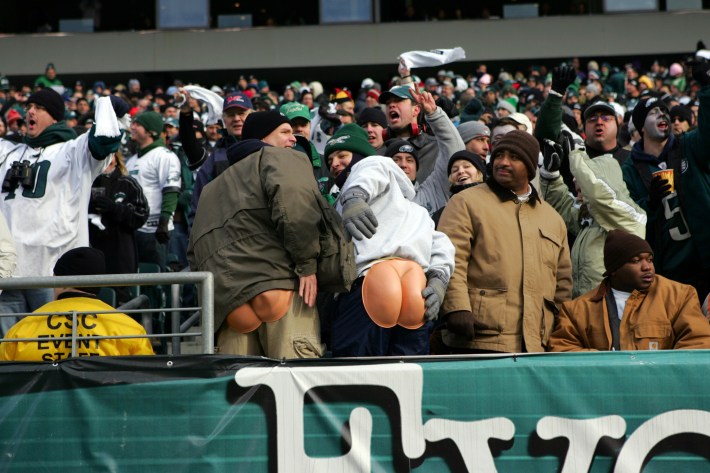
Regardless of the criminological question of whether Eagles Court worked for those it adjudicated, we are fairly confident that it worked for several of the key figures involved in its inception and operations. Seamus McCaffery went from a judge in the relatively lowly Philadelphia Municipal Court to eventually holding a seat on the Pennsylvania Supreme Court. Because judges at all levels in Pennsylvania are elected, Eagles Court as a profile-raising act undoubtedly helped his electoral chances. Even to this day, in the city and beyond he is most known for being the face of Eagles Court, and he still seems to embrace the fame it has brought him.
Councilman Jim Kenney, who set up the meeting between Judge McCaffery and Eagles owner Jeffrey Lurie and team president Joe Banner where Eagles Court was proposed, would go on to become mayor of Philadelphia for two terms. The mayor at the time, Ed Rendell, served as the 45th governor of Pennsylvania from 2003–2011.
The person who might have benefited the most from Eagles Court was Lurie. Having acquired the Eagles in 1994, it is fair to say that he was not receiving the best press on a nightly basis—for various reasons. Certainly, Veterans Stadium did not help. Lurie made it apparent very early on in his tenure that the stadium was falling apart, and it wouldn’t last much longer if he had any say in the matter.
As Veterans Stadium was owned and operated by the city of Philadelphia, the Eagles (and Phillies) had some control over what happened there, but in 1997, it was likely the case that if city officials wanted to put an operational court in the Vet, the Eagles couldn’t have fought it. As a new owner wanting a shiny new stadium of his own (funded by taxpayers, of course), it is easy to imagine Lurie not wanting to open a second front in the public-relations battle over fan behavior by challenging city officials seeking to do something about it. In all likelihood, allowing the city to establish Eagles Court in the stadium helped, in part, to smooth the way to Lurie eventually getting Lincoln Financial Field built and financially speaking, this decision paid off handsomely.
Eagles Court was not without its critics. Then–City Council President John Street went on the record to describe his view that Eagles Court was a separate justice system for fans who, if McCaffery is to be believed, were from outside the city. Street argued that the crimes adjudicated in Eagles Court, had they been committed anywhere else in the city, would have been handled much more harshly, and that Eagles Court was created to treat white suburbanites with kid gloves not usually afforded to young black men in the city’s courts. While there’s something in that comparison, Street’s comments argued for more punishment for bad fan behavior, rather than less punishment for the same behavior elsewhere in the city. Street, after beginning his term as mayor in 2000, was certainly never accused of being soft on crime himself. Although Street’s criticism did not lead to its closure, Eagles Court did eventually end when the team moved to the Linc. What, then, led to the court’s ultimate demise after Jan. 19, 2003, when the final professional football game was played at Veterans Stadium?
We can speculate on the winding down of Eagles Court using the broader crime trends of the time. Just as the birth of Eagles Court was, in part, a product of historically high crime rates, we may be able to attribute the death of it, in part, to the crime drop of the late 1990s. By 2003, when Eagles Court closed, Philadelphia's decreasing crime rate was catching up to the rest of the country, and whether or not this trend directly affected fan behavior, the mood of the time was improving. Combined with the move to Lincoln Financial Field, the mood did not call for an active courtroom in, or even associated with, the new stadium.
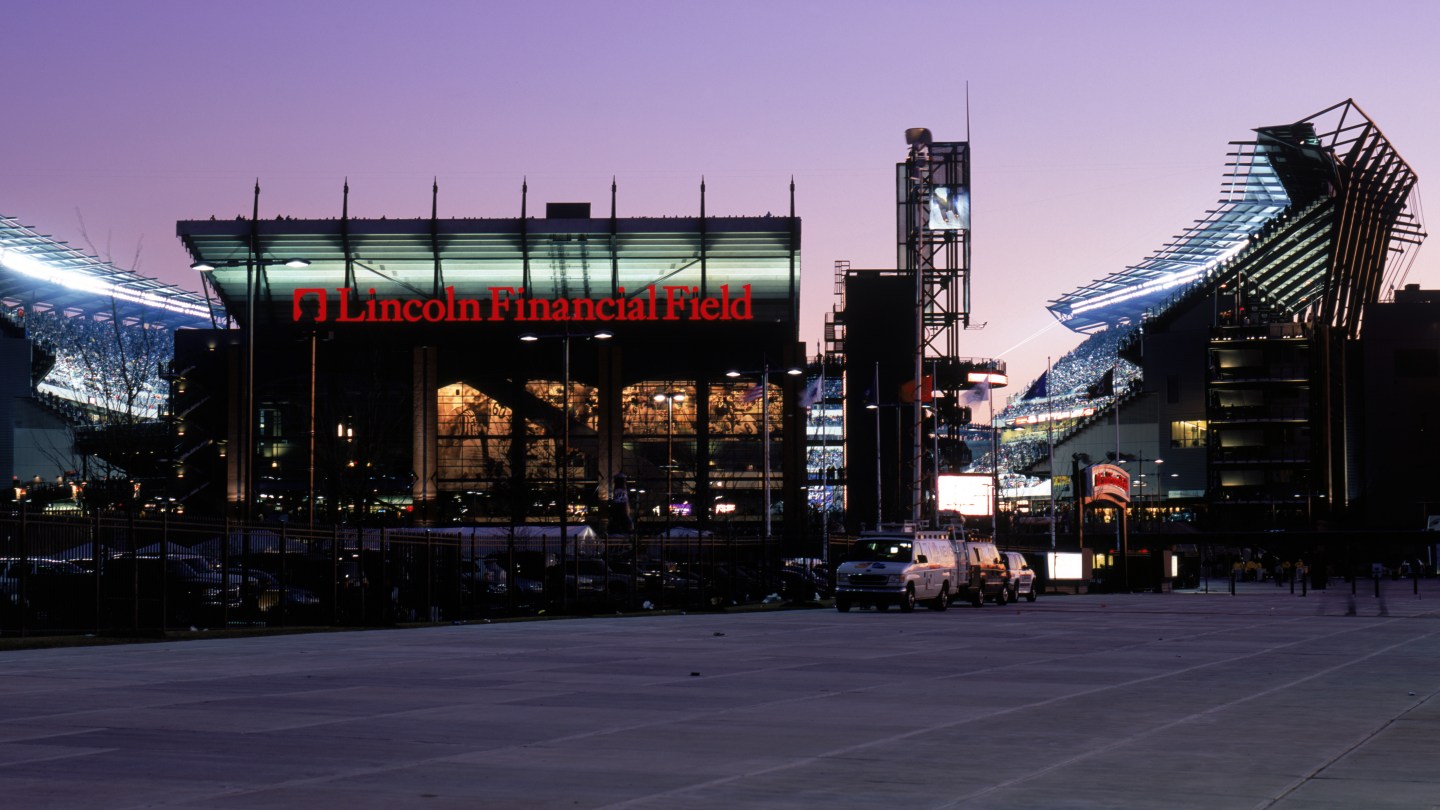
Judge McCaffery repeatedly voiced his displeasure with what he perceived to be a slowdown of cases flowing to Eagles Court, as he and others believed that it was an effective deterrent to bad fan behavior. These are not contradictory statements, at least criminologically speaking. Theoretically, Eagles Court could have become a victim of its own success in that it actually did make fans behave better, resulting in fewer cases being tried there and thus making itself obsolete. In reality, stadium security seemingly soured on the hassle of arresting fans, escorting them to police custody, and allowing the judicial process to play out. Instead, they increasingly took the discretionary tactic of just kicking the drunks out and being done with it. In those final years of Veterans Stadium, there was an unofficial countdown among those who worked there and were looking ahead to their new football-only stadium without the stink of being attached to a functioning court.
As with all new stadiums that replace dilapidated ones, the cost of attending an Eagles home game went up precipitously. At the risk of equating bad fan behavior with people of limited economic means, many of the denizens of the 700 level at the Vet were effectively priced out of the new stadium. Add to this expensive seat licenses and the risk of losing one’s season tickets, and the classic deterrence calculation of balancing the risks with the rewards of using a urinal instead of a sink perhaps tips in favor of pro-social behavior. Relatedly, there is a concept in the criminological literature known as “crime prevention through environmental design.” Just as the design of Veterans Stadium may have facilitated bad behavior through its limited bathrooms and the ease with which fans could move about the stadium, Lincoln Financial Field and other contemporary stadiums are more disjointed, and the systematic unruliness that led to the creation of Eagles Court had largely faded, at least to a point in the public consciousness that such a court was no longer necessary.
In the final analysis, Eagles Court was a one-of-one. Nothing like it ever came before, nothing like it currently exists, and putting an operational courtroom in a sports venue is unlikely to gain purchase again in Philadelphia, or anywhere else for that matter. The uniquely Philadelphian sequence of events and confluence of people and interests that led to the creation of Eagles Court will never quite align in the same way, even if the original recipe for trouble—tens of thousands of drunken strangers gathered together—happens every weekend in the fall all across the country.
Despite this, we hope to have demonstrated that Eagles Court was not some crazy idea that came from nowhere. When analyzed through the history of crime rates and justice-system innovations, Eagles Court, in retrospect, was a good idea in theory, and it was certainly of a piece of the crime boom-and-bust of the late 20th century. In practice, questions remain about its overall effectiveness in influencing fan behavior, but that issue is all but moot at this point. What Eagles Court did was leave an indelible impression on the public, gave an assist to a few powerful men to advance their professional goals, and provided a timeless rhetorical point for whoever has it out for Philly sports fans—to which we say, "We don't care."
